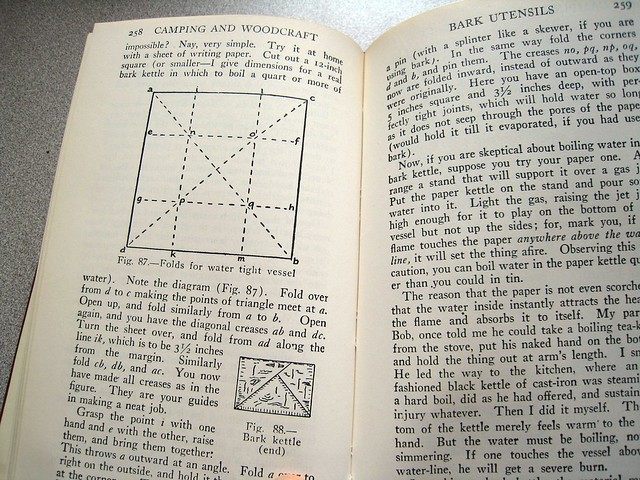I was fascinated by his illustrations of various types of shelter, each with a romantic name like "Hudson Bay tent," and "tomahawk shelter." I couldn't wait to follow his instructions for assembling a bed roll for my next camping trip. He quotes a "southern Indian's" advice on building a fire that won't waste wood (Vol. 1, page 232); something I applied each time we camped. There are many things that distinguish Kephart's book from other camping books--his abundant opinions, his instructions for lost arts, his obvious love for the land and the people who lived their lives immersed in it.
Camping and Woodcraft is an 800+ page, two-volume work. Why would a 12-year-old choose this ancient tome? Honestly, there were few other camping books available to me in the mid-1960s. (Today, the St. Louis County Library system lists 164 books on the subject--still low for a system that holds about 1.4 million books.) Unfortunately, Kephart's books are no longer part of the collection. I'm pretty sure I skipped over the chapter titled "Trophies--Pelts and Rawhide," but I checked the book out several times and eventually read everything else.
The best material is in Vol. II, Woodcraft: splitting a log, building a "masked camp," bee-hunting, "How to Walk," and cabin building. I tried his instructions--pictured above--for "Boiling water in a bark kettle" (Vol. 2, p. 257). Not having access to birch bark in my area, I constructed it from paper. It actually worked! Not only is the paper kettle watertight, and you cook with it and the paper doesn't burn (usually). I tried some recipes too, including "ash cake," but that wasn't exactly a hit with my scout troop. I'd stay away from the sassafras tea too.
I had to wait till the age of Wikipedia to find out more about the author. Most of Kephart's writing is about Appalachia, including the area that later became Great Smokey Mountain National Park, so I assumed he had always lived in that area. Episode 4 of Ken Burns' National Parks covers his contribution to the park and the Appalachian Trail. I was surprised to learn that he had a local connection: he directed the St. Louis Mercantile Library for 13 years. The Mercantile is a private library, established in 1846. I was a member of the library when it was located downtown. Now on the campus of University of Missouri-St. Louis, it's the oldest library still active in the US.
I puzzled over his dedication for a long time: “To the shade of Nessmuk in the Happy Hunting Ground.” Nessmuk (George Sears) and Kephart both wrote for Field and Stream and both were obsessed with wilderness. Born in 1821, Nessmuk is another throw-back who regarded progress as a very mixed blessing. It took a lot longer to run down Nessmuk's writings (now also available free from Gutenberg.org).
Some of Kephart's projects would no longer be considered "green," such as marking a trail with a hatchet and building a bed with fresh pine boughs nightly, but his enthusiasm for living simply, surrounded by forests, rocks, and sky make it worth reading even in the 21st Century.
I puzzled over his dedication for a long time: “To the shade of Nessmuk in the Happy Hunting Ground.” Nessmuk (George Sears) and Kephart both wrote for Field and Stream and both were obsessed with wilderness. Born in 1821, Nessmuk is another throw-back who regarded progress as a very mixed blessing. It took a lot longer to run down Nessmuk's writings (now also available free from Gutenberg.org).
Some of Kephart's projects would no longer be considered "green," such as marking a trail with a hatchet and building a bed with fresh pine boughs nightly, but his enthusiasm for living simply, surrounded by forests, rocks, and sky make it worth reading even in the 21st Century.
Happy Earth Day, Horace! Maybe some other folks out there in the blogosphere would like to participate in this 3-book tribute. Check out the description of the meme! The rest of my book list will have to wait for a later post.

What an interesting book... and I am familiar with some of Kephart's other work about the area, since my husband hails from Appalachia. We camp a lot and I will have to look for this book as a companion to our travels! Thanks for participating (I just posted my reading too!)
ReplyDeleteWe can learn a lot from Native American culture. They were very respectful of the earth and always gave back. What a great choice! I enjoyed your in-depth description very much. And I can't wait to read more about your selections. Thank you for joining in The Earth Day Reading Project. Happy Earth Day!
ReplyDeleteLove the book you chose...it is fascinating the great books that were in the libraries when we were growing up...it sounds a lot like what we did in Camp Fire Grils...very steeped in native American lore...makes me think another post may come from those wonderful memories...thx for sharing and visiting my blog..Happy Earth Day
ReplyDeleteHi Lisa! I thought I was the only one who knew about Kephart, till I saw Burns' series on the National Parks. Great to hear you're familiar with his books too. Thanks again for inviting me! I had fun reading your Earth Day reading project post and many others!
ReplyDeleteHi Sage Butterfly! You designed such a wonderful project--thanks for all your work! I loved your list too. I hope many people visit and get inspired to celebrate Earth Day!
ReplyDeleteYou're right Donna, I'm thinking about a post about libraries. We take them for granted too often! Native American culture, even in its watered down popular version, has inspired so many to take a second look at the beauty and diversity around us. I enjoyed your post on the project too!
ReplyDelete